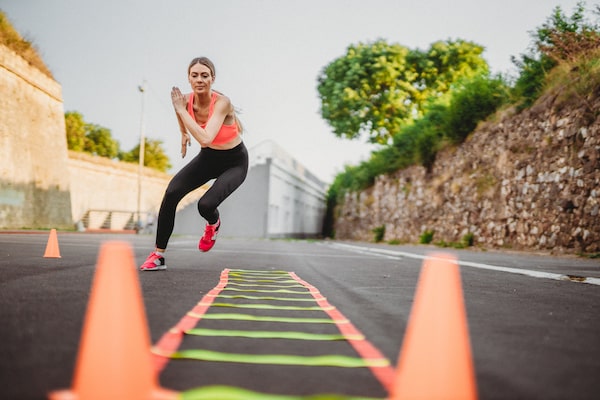
Engaging in dedicated agility training once or twice a week is ideal, experts say.milan2099/Getty Images
Shuttle runs. Cariocas. Side shuffles. Hurdles. While dedicated agility drills were a mainstay of grade-school gym class, they may no longer be part of your workout regimen unless you’re currently playing a professional sport. But experts say they should be.
Focusing on agility – the ability to stop, start or change direction without losing balance, control or speed – helps kids develop bodily control and co-ordination and is crucial for athletes who need to be able to respond to a moving object. It’s also important for weekend warriors looking to avoid injury while dominating a doubles game, commuters who need to dodge pedestrians to catch the bus, and seniors concerned about mitigating everyday trip-and-fall risks.
Being agile is particularly important later in life, when declining cognitive function, difficulty focusing, and diminished balance can lead to more frequent falls. In older adults, “the overall capacity to do things simultaneously is reduced” says Eric Lichtenstein, a lecturer and applied statistician at the Exercise and Training Science Section of the University of Basel. It’s something you may not notice until it becomes an issue.
A third of all seniors experience a fall once a year, and half of that number will fall again the following year. Falls are the leading cause of hospitalizations as a result of injury in seniors over 65 and can signal the end of independence in some cases.
“When you’re 20 or 30 a fall is an inconvenience,” says Stuart Phillips, a professor of kinesiology at McMaster University and a Tier 1 Canada Research Chair in Skeletal Muscle Health. “In your 40s, I think it becomes more important. In your 50s it becomes an issue. In your 60s it’s a big issue. In your 70s it’s a major issue.”
Agility training can improve overall strength which can make it easier to catch yourself if you trip, and resistance training can help stave off osteoporosis, mitigating the likelihood of a fall-related fracture. One Vancouver-based study involving 98 senior women, found that fall risk was reduced by nearly 50 per cent over a 25-week agility training intervention, owing largely to improvements in postural stability (the ability to control the body in space).
That said, it’s important to include dedicated strength training in your training regimen as well.
“Agility should be one part of the equation,” says Lichtenstein. He suggests complementing agility-specific training with a session focusing on strength and explosiveness, which increases the amount of force produced by muscles during a movement. “I think those two things together would be best because then you have the ability to catch yourself if you fall, and you avoid most situations when you fall,” he says.
How do I get started?
To determine how to work with an older client, Toronto-based physiotherapist David London uses a series of basic tests, such as the Timed Up and Go (TUG) test, the 8-Foot Up and Go (8UG) test, or the Functional Reach test. In observing their performance, he’s analyzing their ability to respond to external forces while maintaining balance and control: Can they make rapid changes in direction? Adapt to unexpected disturbances?
Both Phillips and Lichtenstein recommend working one-on-one with a coach or in a small group when beginning an agility training program, as an agility program will look different depending on your age and ability level. Lichtenstein also emphasizes the importance of not being overly gentle.
“People are afraid to challenge older adults,” he says. “But if you don’t challenge them, they don’t get better. That means performing a task where there is the possibility to fail.”
At-home drills
Alison Scott, a personal trainer and the owner of PUSH Training, works with older clientele and offered a few of her go-to agility drills that you can perform in the gym or at home:
Box Cone Drill
Set up four cones (or any four items) in a square. Walk/run forward to the first corner, then side shuffle to the next corner, backpedal to the third corner, and side shuffle back to the start. Repeat in the other direction, starting with a side shuffle. This is one rep.
T Cone Drill
Set up four cones to look like an uppercase T. Run/walk forward from the first cone to the centre cone at the top of the T. Side shuffle to the cone on the right side, then side shuffle all the way to the left side, then back to the centre cone. Run/walk backward to the starting cone. Repeat by switching the direction of the side shuffle to use the non-dominant side. This is one rep.
Skipping Rope
You can jump with both feet at the same time, hop on one foot and then switch feet, or alternate one-foot hops. Try to go for 20-30 seconds.
With each exercise, aim for three sets with 30-60 seconds rest in between sets.
Engaging in dedicated agility training once or twice a week is ideal, according to all of our experts. As you improve, Lichtenstein suggests, challenge yourself by seeing if you can complete the same moves faster than before.
When you do start an agility regimen, it’s important that you stick with it; while there’s some evidence to show that cognitive improvements can last over time without consistent training, the muscular strength needed to maintain balance requires consistent training.
There’s emotional value in knowing that the obstacles we might encounter can pose less of a risk too. Phillips says the seniors he sees at McMaster’s Physical Activity Centre of Excellence report that “movements become easier: getting in and out of a car, going up and down stairs. I move with more confidence. And in being confident, I do more things. And in doing more things, my world, my life space gets a little bigger.”
Alyssa Ages is a journalist and the author of Secrets of Giants: A Journey to Uncover the True Meaning of Strength, published by Avery/Penguin Random House in September, 2023. She is also a strongman competitor and endurance athlete, as well as a former personal trainer and group fitness instructor.
 Alyssa Ages
Alyssa Ages